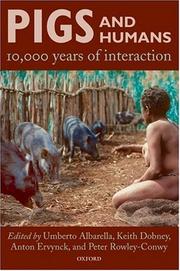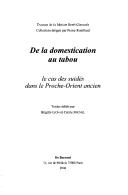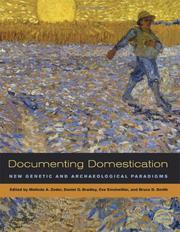| Listing 1 - 5 of 5 |
Sort by
|
Book
ISBN: 3805542127 Year: 1986 Publisher: Basel Paris Tokyo Karger
Abstract | Keywords | Export | Availability | Bookmark
 Loading...
Loading...Choose an application
- Reference Manager
- EndNote
- RefWorks (Direct export to RefWorks)
Book
ISBN: 9781407357362 1407357360 Year: 2020 Publisher: Oxford BAR Publishing
Abstract | Keywords | Export | Availability | Bookmark
 Loading...
Loading...Choose an application
- Reference Manager
- EndNote
- RefWorks (Direct export to RefWorks)
The domestication of the wild boar and the emergence of the domestic pig are a fundamental aspect of the Neolithic and a key moment in human history. This book represents the most comprehensive zooarchaeological study to date of the origins and evolution of the domestication of the pig in the Italian peninsula, from a wide regional scale and a diachronic perspective. Some key archaeological questions addressed concern how and when the process of pig domestication commenced in Italy, how it evolved, and how it compares with the wider European and Middle Eastern scenarios. Through the collection of mainly biometrical data from several Italian prehistoric sites, this book explores changes in pig management through time, from the Upper Palaeolithic to the Bronze Age. The results are articulated with both historical changes in Italian societies and evidence from other areas, to achieve a comprehensive understanding of domestication.
Swine --- Domestication --- History. --- Animals, Fossil --- Animal remains (Archaeology) --- Animals, Domestication of --- Animal training --- Domestic animals --- Pets --- Domestic pig --- Hogs --- Pig --- Pig farming --- Pigs --- Sus domestica --- Sus domesticus --- Sus scrofa domestica --- Sus scrofa domesticus --- Livestock --- Sus --- History --- Social aspects

ISBN: 0191917354 1281149004 9786611149000 0191525790 1435617630 9780191525797 9780199207046 0199207046 9781281149008 6611149007 9781435617636 9780191917356 Year: 2007 Publisher: Oxford [etc.] Oxford University Press
Abstract | Keywords | Export | Availability | Bookmark
 Loading...
Loading...Choose an application
- Reference Manager
- EndNote
- RefWorks (Direct export to RefWorks)
A collection of essays focusing upon the role wild and domestic pigs have played in human societies around the world over the last 10,000 years. The 22 contributors cover a broad and diverse range of themes, grounded within the disciplines of archaeology, zoology, anthropology, and biology, as well as art history and history.
Swine --- Human-animal relationships --- Domestic pig --- Hogs --- Pig --- Pig farming --- Pigs --- Sus domestica --- Sus domesticus --- Sus scrofa domestica --- Sus scrofa domesticus --- Livestock --- Sus --- History. --- 63 <09> --- 636.4 --- 636.4 Pigs. Swine --- Pigs. Swine --- 63 <09> History of agriculture --- History of agriculture --- History --- Porc --- Relations homme-animal --- Histoire

ISBN: 2701802105 9782701802107 Year: 2006 Volume: 1 Publisher: Paris Diffusion De Boccard
Abstract | Keywords | Export | Availability | Bookmark
 Loading...
Loading...Choose an application
- Reference Manager
- EndNote
- RefWorks (Direct export to RefWorks)
Food habits --- Taboo --- Meat --- Swine --- Muslims --- Jews --- Habitudes alimentaires --- Tabou --- Viande --- Porcs --- Pocs --- Musulmans --- Juifs --- History --- Congresses --- Religious aspects --- Islam --- Judaism --- Dietary laws --- Histoire --- Congrès --- Aspect religieux --- Judaïsme --- Lois alimentaires --- Ethno-cultural history - Near East - Pork in food. --- Pork --- Judaism t --- Congrès --- Judaïsme --- Purity, Ritual --- Religion --- Sacrilege --- Domestic pig --- Hogs --- Pig --- Pig farming --- Pigs --- Sus domestica --- Sus domesticus --- Sus scrofa domestica --- Sus scrofa domesticus --- Livestock --- Sus --- Pork-free diet --- Mohammedans --- Moors (People) --- Moslems --- Muhammadans --- Musalmans --- Mussalmans --- Mussulmans --- Mussulmen --- Religious adherents --- Hebrews --- Israelites --- Jewish people --- Jewry --- Judaic people --- Judaists --- Ethnology --- Semites --- Eating --- Food customs --- Foodways --- Human beings --- Habit --- Manners and customs --- Diet --- Nutrition --- Oral habits

ISBN: 1282358936 1423789652 9786612358937 0520932420 1601293828 9780520932425 9781423789659 9781601293824 0520246381 9780520246386 9780520246386 0520246381 9781282358935 Year: 2006 Publisher: Berkeley, Calif. University of California Press
Abstract | Keywords | Export | Availability | Bookmark
 Loading...
Loading...Choose an application
- Reference Manager
- EndNote
- RefWorks (Direct export to RefWorks)
Agriculture is the lever with which humans transformed the earth over the last 10,000 years and created new forms of plant and animal species that have forever altered the face of the planet. In the last decade, significant technological and methodological advances in both molecular biology and archaeology have revolutionized the study of plant and animal domestication and are reshaping our understanding of the transition from foraging to farming, one of the major turning points in human history. This groundbreaking volume for the first time brings together leading archaeologists and biologists working on the domestication of both plants and animals to consider a wide variety of archaeological and genetic approaches to tracing the origin and dispersal of domesticates. It provides a comprehensive overview of the state of the art in this quickly changing field as well as reviews of recent findings on specific crop and livestock species in the Americas, Eurasia, and Africa. Offering a unique global perspective, it explores common challenges and potential avenues for future progress in documenting domestication.
Evolution. --- Crops, Agricultural --- Archaeology. --- Adaptation, Biological --- Animals, Domestic --- Animal remains (Archaeology) --- Domestic animals --- Plant remains (Archaeology) --- Plants, Cultivated --- Archaeobotanical assemblages --- Archaeobotanical material --- Archaeobotanical remains --- Archaeobotany --- Archaeological plant remains --- Archaeology, Botanical --- Assemblages, Archaeobotanical --- Botanical archaeology --- Botany in archaeology --- Material, Archaeobotanical --- Phytoarchaeology --- Remains, Archaeobotanical --- Remains, Plant (Archaeology) --- Remains, Vegetal (Archaeology) --- Vegetal remains (Archaeology) --- Archaeology --- Paleobotany --- Anthracology --- Plant genetics --- Archaeozoology --- Zooarchaeology --- Zoology in archaeology --- Bones --- Animal paleopathology --- Animal genetics --- Archeology --- Bioarchaeology --- genetics. --- Genetics. --- Methodology --- Evolution --- Genetics --- genetics --- Plantes cultivées --- Restes de plantes (Archéologie) --- Animaux domestiques --- Restes d'animaux (Archéologie) --- Génétique --- Adaptation, Biological - genetics. --- agriculture. --- andes. --- animal domestication. --- anthropology. --- archaeology. --- banana. --- camelids. --- cassava. --- cattle. --- chives. --- domestic pets. --- donkeys. --- farming. --- fertile crescent. --- foraging. --- goats. --- herbs. --- history. --- horses. --- human behavior. --- hunter gatherer. --- indigenous culture. --- indigenous people. --- maize. --- mesopotamia. --- molecular biology. --- natural world. --- nature. --- nonfiction. --- olives. --- pig. --- plant domestication. --- science. --- sheep. --- social development. --- social history. --- squash. --- starch grain. --- tropical america. --- tubers.
| Listing 1 - 5 of 5 |
Sort by
|

 Search
Search Feedback
Feedback About UniCat
About UniCat  Help
Help News
News